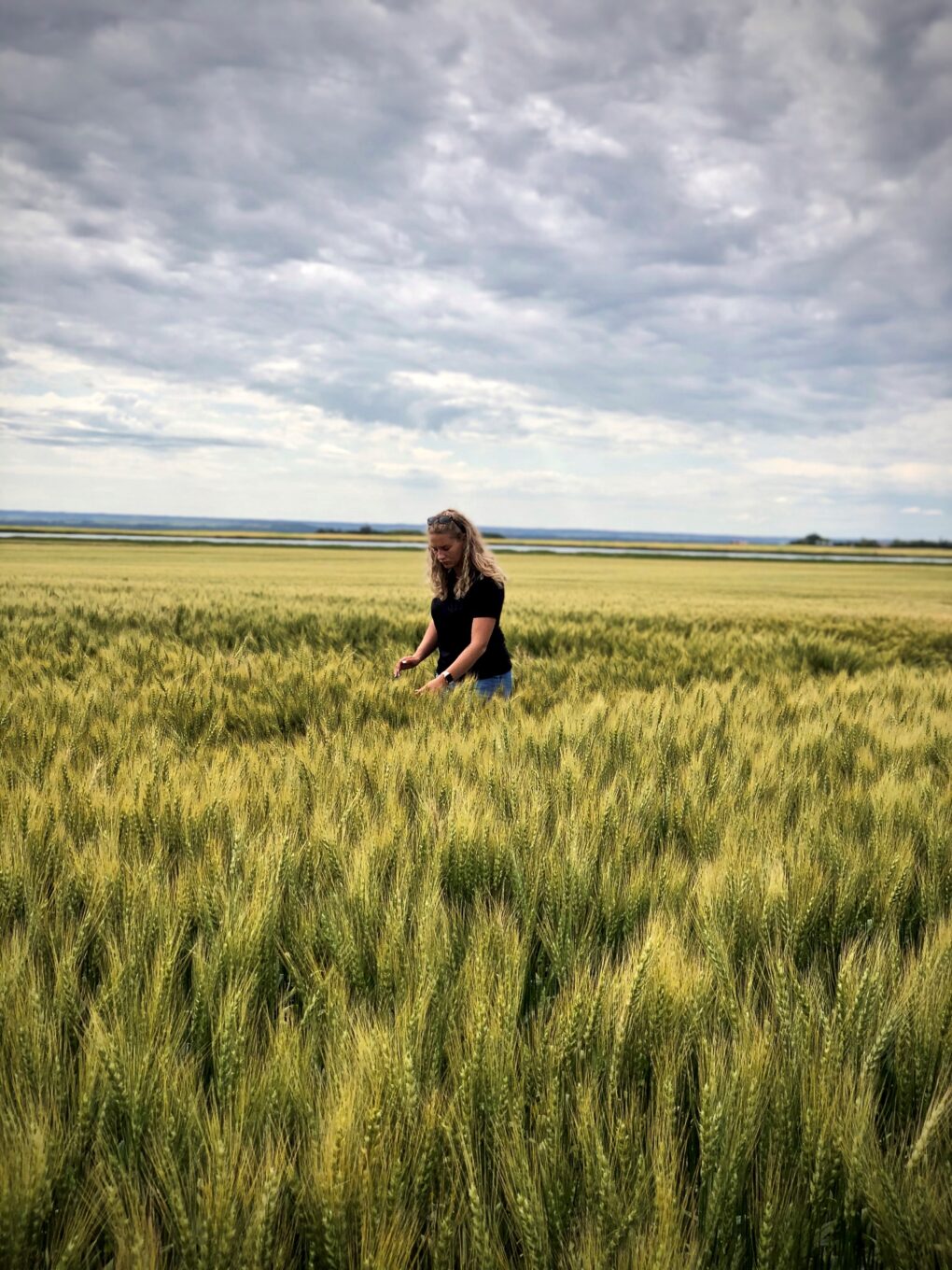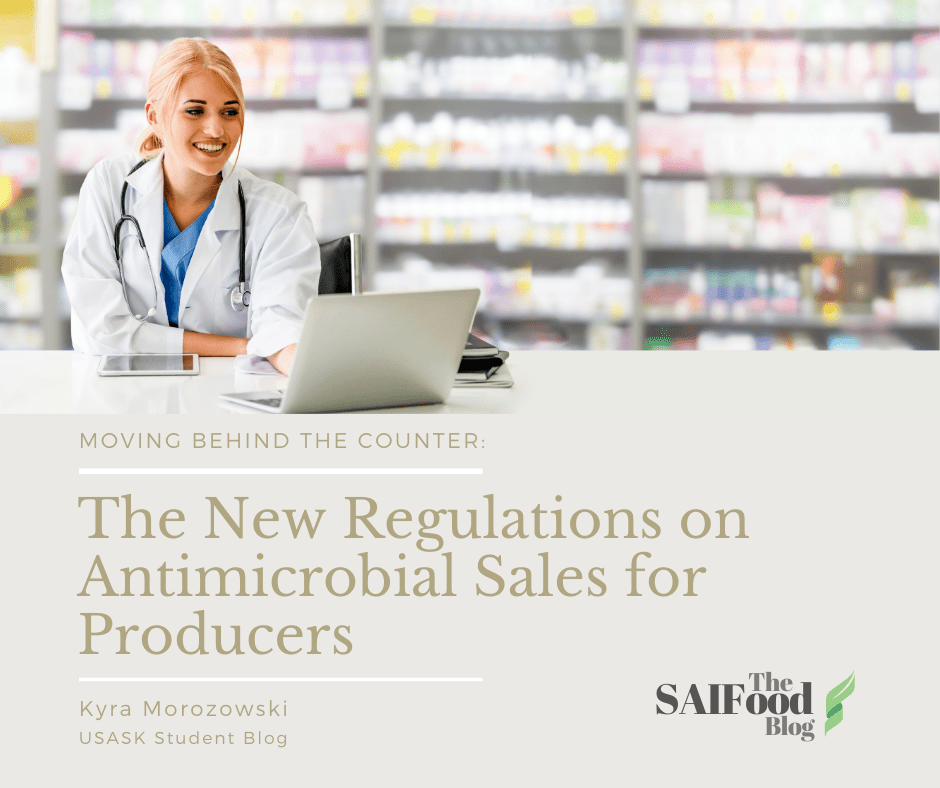By: Kyra Morozowski, University of Saskatchewan student
Increased Worry Calls for Change
Antimicrobial resistance is now a growing health concern for the public health sector in Canada (Government of Canada 2017a). Producers who previously bought their antimicrobials from the local feed store are no longer able to do so. Now to purchase any sort of medically important antimicrobial (MIA) for therapeutic purposes, a producer will need a prescription from their veterinarian (Alberta Beef Producers 2018). MIA’s are used for three main reasons in livestock production. They include the treatment of illness caused by bacteria, prevention of these illnesses, and to promote the growth and feed efficiency in beef cattle (Canadian Beef 2017). These changes were implemented in December of 2018 by Health Canada to ensure two things. The first thing was to ensure the proper use of MIA to slow or avoid MIA resistant bacteria. This in turn ensures we will have antimicrobial options for years to come. The second was to strengthen public trust by demonstrating responsible use by producers (Alberta Beef Producers 2018). The public has begun to have increased worries regarding the use of MIA in production animals and if the overuse in animals could contribute to antimicrobial resistance (AMR) in humans (Knetsch et al. 2018). Antimicrobials are sometimes not properly used in human and animal health (Government of Canada 2017b), whether it be over or under-dosing, not following the appropriate time frame, or using them to treat ailments that do not require it. All of these improper uses lead to eventual antimicrobial resistance.
How Does This Affect Producers?
Before December of 2018 producers were able to walk into their local feed store or ag centre and pick up a bottle of penicillin or tetracycline to treat pink eye or foot rot. This no longer is the case. Now producers will need a prescription to purchase these types of medication. Producers may be concerned with the inconvenience of this, but there are ways to address it. According to the Canadian Veterinarian Medical Association (2020), establishing a Veterinarian-Client-Patient-Relationship or VCPR is the first step that needs to be taken. Establishing a VCPR allows your veterinarian to have a better understanding of your operation and how your preventative health program runs. Once a solid VCPR has been founded, you and your veterinarian can determine how much antimicrobials you will need your farm based on your herd health records and history disease in the operation. Your veterinarian can write you a prescription for X amount and the producer can buy up to that amount until the prescription expires (Alberta Beef Producers 2018). This allows producers to not have to call the vet out to the farm every time they have a case of pink eye or other minor ailments. Most producers have a good idea of what does and do not need to be treated with antimicrobials, but if you are unsure make sure to consult your veterinarian. The need for a well-established VCPR cannot be stressed enough, you cannot just walk into a vet’s office and expect this to happen.
How Does Antimicrobial Resistance Occur?
Antimicrobials are natural or synthetic substances that are used to prevent or treat infections/diseases caused by bacteria (Canadian Beef 2017). The keyword in that definition is BACTERIA. Anything that is not caused by a bacterium cannot be treated by antimicrobials, as these are viral infections and antimicrobials will not work on viruses (Kent 2019). This is where we start to run into issues. Misdiagnoses of something being bacterial when it is viral leads to unnecessary use of antimicrobials and the treatment is useless. Misuse, over and underdosing, not following the given time frame are all causes of AMR, which are common in both the human and animal health world (Government of Canada 2017b). These misuses of the MIA lead the bacteria to adapt to its environment and change its DNA, allowing them to fight off the MIA and render it useless against the bacteria (Usha et al. 2010). When the bacteria adapt like this it reduces the selection of MIA, we have to treat infections in both humans and animals. These AMR bacteria can also spread just like any other bacteria, allowing them to be introduced to new environments causing resistance before the drug has even been administered (Government of Canada 2017b).

What Can We Do to Reduce the Risk?

Ensuring that we as producers are using MIA responsibly is a major step in the right direction. Also promoting proper stewardship is important. The better the conditions our livestock are raised in, the better the chances are that you will not have to use antimicrobials. This can include things like stress-free handling, ensuring you are on top of nutrition for your animals, providing a clean and safe environment, and performing regular herd health checks (Government of Canada 2017b). As well, we as humans making sure we are taking any prescribed medication as directed to help reduce the risk of resistance in the human health field.
- Alberta Beef Producers 2018. The way you purchase antibiotics is changing. Canadian Beef 2017. UNDERSTANDING Antibiotics and Beef Cattle. [Online] Available: https://canadabeef.ca/wp-content/uploads/2018/01/3430_CANBEEF_factsheet_ANTIBIOTICS-DEC2017.pdf.
- Canadian Veterinarian Medical Association 2020. ESTABLISHING A VALID VETERINARIAN-CLIENT-PATIENT-RELATIONSHIP. [Online] Available: https://www.canadianveterinarians.net/valid-vcpr [2020 Sep. 25].
- Government of Canada 2017a. Antimicrobial resistance and animals – Actions. [Online] Available: https://www.canada.ca/en/public-health/services/antibiotic-antimicrobial-resistance/animals/actions.html [2020 Sep. 21].
- Government of Canada 2017b. Science Fact Sheet: Antimicrobial Resistance. [Online] Available: https://www.inspection.gc.ca/about-cfia/science-and-research/our-research-and-publications/science-fact-sheet-antimicrobial-resistance/eng/1509647559865/1509647560617 [2020 Sep. 21].
- Kent, D. 2019. Antibiotics and common illnesses. [Online] Available: https://wa.kaiserpermanente.org/healthAndWellness/index.jhtml?item=%2Fcommon%2FhealthAndWellness%2Fmedications%2FmanagingMedications%2Fantibiotics.html.
- Knetsch, C.W., Kumar, N., Forster, S.C., Connor, T.R., Browne, H.P., Harmanus, C., Sanders, I.M., Harris, S.R., Turner, L., Morris, T., Perry, M., Miyajima, F., Roberts, P., Pirmohamed, M., Songer, J.G., Weese, J.S., Indra, A., Corver, J., Rupnik, M., Wren, B.W., Riley, T. V., Kuijper, E.J., and Lawley, T.D. 2018. Zoonotic transfer of Clostridium difficile harboring antimicrobial resistance between farm animals and humans. J. Clin. Microbiol. 56: 1–8. doi:10.1128/JCM.01384-17.
- Usha, P.T.A., Jose, S., and Nisha, A.R. 2010. Antimicrobial drug resistance – A global concern. Vet. World 3: 138–139.

Kyra Morozowski
I grew up just outside of the small-town of Glaslyn in North Central Saskatchewan on a small farm. On our farm, Blue Moon Alpacas, we raise and breed purebred Huacaya alpacas. My love for animals is what made my decision for picking the College of Agriculture an easy one. I did not have much agriculture experience in terms of grain farming aside from what I learned from hanging out with my farm friends, but any chance I got to work with animals I was there. I started working for a Crop Inputs company over the last three summers and have grown to love the industry even more than I already did and I am excited about my future in the it. I have learned lots and can’t wait to learn more. I am in my fourth and final year of my Animal Science Degree with a minor in AgBusiness and I am looking forward to getting a full-time job in this wonderful industry once I have graduated in the spring (2021).


